Prediction of the Deterioration of FRP Composite Properties Induced by Marine Environments
Abstract
:1. Introduction
2. Materials and Methods
2.1. Experimental Investigation
2.2. Numerical Analysis
2.2.1. Tensile Test Modelling
2.2.2. Regression Analysis
2.2.3. Structural Durability Assessment
3. Results
3.1. Regression Analysis Results
3.2. Prediction of Fatigue Life Behavior
4. Discussion
5. Conclusions
- An initial mathematical model of these phenomena was developed based on the experimental data gathered.
- The loss of ultimate strength required corrections of the procedures used for predicting the fatigue life of composites exposed to the sea.
- The reduction in ultimate tensile strength for composite materials exposed to the marine environment has a direct influence on the materials’ fatigue behavior.
- The research results confirmed once again the importance of biofouling in the environmental degradation of the mechanical properties of composite materials in the marine environment.
- Future work is needed to develop a numerical method to encompass the continuous UTS decay and increase the accuracy of the prediction model.
Author Contributions
Funding
Institutional Review Board Statement
Informed Consent Statement
Data Availability Statement
Conflicts of Interest
References and Notes
- Kim, D.-U.; Seo, H.-S.; Jang, H.-Y. Study on Mechanical Bearing Strength and Failure Modes of Composite Materials for Marine Structures. J. Mar. Sci. Eng. 2021, 9, 726. [Google Scholar] [CrossRef]
- Wang, C.; Ge, S.; Jaworski, J.W.; Liu, L.; Jia, Z. Effects of Different Design Parameters on the Vortex Induced Vibration of FRP Composite Risers Using Grey Relational Analysis. J. Mar. Sci. Eng. 2019, 7, 231. [Google Scholar] [CrossRef] [Green Version]
- Vukelic, G.; Vizentin, G. Composite wrap repair of a failed pressure vessel–Experimental and numerical analysis. Thin-Walled Struct. 2021, 169, 108488. [Google Scholar] [CrossRef]
- Vukelic, G.; Vizentin, G.; Bakhtiari, R. Failure analysis of a steel pressure vessel with a composite wrap repair proposal. Int. J. Press. Vessel. Pip. 2021, 193, 104476. [Google Scholar] [CrossRef]
- Lukács, J.; Koncsik, Z.; Chován, P. Integrity reconstruction of damaged transporting pipelines applying fiber reinforced polymer composite wraps. Procedia Struct. Integr. 2021, 31, 51–57. [Google Scholar] [CrossRef]
- Cejuela, E.; Negro, V.; Del Campo, J.M. Evaluation and Optimization of the Life Cycle in Maritime Works. Sustainability 2020, 12, 4524. [Google Scholar] [CrossRef]
- De Ulzurrun, I.D.; López, F.; Herreros, M.; Suárez, J. Tests of deck-to-hull adhesive joints in GFRP boats. Eng. Fail. Anal. 2007, 14, 310–320. [Google Scholar] [CrossRef]
- Lee, S.-G.; Oh, D.; Woo, J. The Effect of High Glass Fiber Content and Reinforcement Combination on Pulse-Echo Ultrasonic Measurement of Composite Ship Structures. J. Mar. Sci. Eng. 2021, 9, 379. [Google Scholar] [CrossRef]
- Junior, M.W.; Reis, J.; Mattos, H.D.C. Polymer-based composite repair system for severely corroded circumferential welds in steel pipes. Eng. Fail. Anal. 2017, 81, 135–144. [Google Scholar] [CrossRef]
- Yang, Z.; Cao, Y.; Liu, J. A Buckling Analysis and Optimization Method for a Variable Stiffness Cylindrical Pressure Shell of AUV. J. Mar. Sci. Eng. 2021, 9, 637. [Google Scholar] [CrossRef]
- Durability of Composites in a Marine Environment. In Solid Mechanics and Its Applications; Davies, P.; Rajapakse, Y.D.S. (Eds.) Springer: Dordrecht, The Netherlands, 2014; Volume 208, ISBN 978-94-007-7416-2. [Google Scholar]
- Durability of Composites in a Marine Environment 2. In Solid Mechanics and Its Applications; Davies, P.; Rajapakse, Y.D.S. (Eds.) Springer International Publishing: Cham, Switzerland, 2018; Volume 245, ISBN 978-3-319-65144-6. [Google Scholar]
- Martin, R. Ageing of Composites; Woodhead Publishing Limited: Cambridge, UK, 2008; ISBN 978-1-84569-352-7. [Google Scholar]
- Takacs, L.; Kovacs, L.; Olajos, T. Numerical tool with mean-stress correction for fatigue life estimation of composite plates. Eng. Fail. Anal. 2020, 111, 104456. [Google Scholar] [CrossRef]
- Gljušćić, M.; Franulović, M.; Lanc, D.; Božić, Ž. Digital image correlation of additively manufactured CFRTP composite systems in static tensile testing. Procedia Struct. Integr. 2021, 31, 116–121. [Google Scholar] [CrossRef]
- Brčić, M.; Kršćanski, S.; Brnić, J. Rotating Bending Fatigue Analysis of Printed Specimens from Assorted Polymer Materials. Polymers 2021, 13, 1020. [Google Scholar] [CrossRef]
- Venkatesan, K.; Ramanathan, K.; Vijayanandh, R.; Selvaraj, S.; Kumar, G.R.; Kumar, M.S. Comparative structural analysis of advanced multi-layer composite materials. Mater. Today Proc. 2020, 27, 2673–2687. [Google Scholar] [CrossRef]
- Kastratović, G.; Grbović, A.; Sedmak, A.; Božić, Ž.; Sedmak, S. Composite material selection for aircraft structures based on experimental and numerical evaluation of mechanical properties. Procedia Struct. Integr. 2021, 31, 127–133. [Google Scholar] [CrossRef]
- Sousa, J.; Marques, J.; Garcia, M.; Infante, V.; Amaral, P. Mechanical characterization of sandwich composites with embedded sensors. Eng. Fail. Anal. 2020, 117, 104765. [Google Scholar] [CrossRef]
- Tomasz, M.; Szymon, D.; Bartosz, B.; Joanna, W.; Paweł, Z.; Grzegorz, L. Flexural and compressive residual strength of composite bars subjected to harsh environments. Eng. Fail. Anal. 2022, 133, 105958. [Google Scholar] [CrossRef]
- Vizentin, G.; Glujić, D.; Špada, V. Effect of Time-Real Marine Environment Exposure on the Mechanical Behavior of FRP Composites. Sustainability 2021, 13, 9934. [Google Scholar] [CrossRef]
- Vizentin, G.; Vukelic, G. Degradation and Damage of Composite Materials in Marine Environment. Mater. Sci. 2019, 26, 337–342. [Google Scholar] [CrossRef] [Green Version]
- Tamboura, S.; Abdessalem, A.; Fitoussi, J.; Ben Daly, H.; Tcharkhtchi, A. On the mechanical properties and damage mechanisms of short fibers reinforced composite submitted to hydrothermal aging: Application to sheet molding compound composite. Eng. Fail. Anal. 2022, 131, 105806. [Google Scholar] [CrossRef]
- Padmaraj, N.; Vijaya, K.M.; Shreepannaga; Amritha, U.; Dayananda, P. Slurry erosion behaviour of carbon/epoxy quasi-isotropic laminates based on Taguchi’s optimization method. Eng. Fail. Anal. 2021, 123, 105274. [Google Scholar] [CrossRef]
- Rubino, F.; Nisticò, A.; Tucci, F.; Carlone, P. Marine Application of Fiber Reinforced Composites: A Review. J. Mar. Sci. Eng. 2020, 8, 26. [Google Scholar] [CrossRef] [Green Version]
- DNV-OS-C501 Composite Components. Det Nor. Verit. 2010, 119–134.
- Djeghader, D.; Redjel, B. Fatigue of Glass-Polyester Composite Immerged in Water. J. Eng. Sci. Technol. 2017, 12, 1204–1215. [Google Scholar]
- Smith, L.V.; Weitsman, Y.J. The immersed fatigue response of polymer composites. Int. J. Fract. 1996, 82, 31–42. [Google Scholar] [CrossRef]
- Vázquez, J.; Silvera, A.; Arias, F.; Soria, E. Fatigue properties of a glass-fibre-reinforced polyester material used in wind turbine blades. J. Strain Anal. Eng. Des. 1998, 33, 183–193. [Google Scholar] [CrossRef]
- Kennedy, C.R.; Leen, S.B.; Brádaigh, C.M. Ó Immersed Fatigue Performance of Glass Fibre-Reinforced Composites for Tidal Turbine Blade Applications. J. Bio-Tribo-Corrosion 2016, 2, 12. [Google Scholar] [CrossRef] [Green Version]
- Gagani, A.I.; Mialon, E.P.; Echtermeyer, A.T. Immersed interlaminar fatigue of glass fiber epoxy composites using the I-beam method. Int. J. Fatigue 2019, 119, 302–310. [Google Scholar] [CrossRef]
- Zhang, W.; Zhou, Z.; Zhang, B.; Zhao, S. A phenomenological fatigue life prediction model of glass fiber reinforced polymer composites. Mater. Des. 2015, 66, 77–81. [Google Scholar] [CrossRef]
- Mouritz, A.P. A Simple Fatigue Life Model for Three-dimensional Fiber-Polymer Composites. J. Compos. Mater. 2006, 40, 455–469. [Google Scholar] [CrossRef]
- Yasar, A.; Kacar, I.; Keskin, A. Tensile and Fatigue Behavior of Glass Fiber-Reinforced (MAT-8)/Polyester Automotive Composite. Arab. J. Sci. Eng. 2014, 39, 3191–3197. [Google Scholar] [CrossRef]
- Burhan, I.; Kim, H.S. S-N Curve Models for Composite Materials Characterisation: An Evaluative Review. J. Compos. Sci. 2018, 2, 38. [Google Scholar] [CrossRef] [Green Version]
- Vizentin, G.; Vukelic, G. Failure Analysis of FRP Composites Exposed to Real Marine Environment. Procedia Struct. Integr. 2022, 37, 233–240. [Google Scholar] [CrossRef]
- International Standard ISO 527; Plastics–Determination of Tensile Properties. ISO: Geneva, Switzerland, 2020.
- Choi, Y.Y.; Lee, S.H.; Park, J.-C.; Choi, D.J.; Yoon, Y.S. The impact of corrosion on marine vapour recovery systems by VOC generated from ships. Int. J. Nav. Arch. Ocean Eng. 2019, 11, 52–58. [Google Scholar] [CrossRef]
- Kovač, N.; Ivošević, Š.; Vastag, G.; Vukelić, G.; Rudolf, R. Statistical Approach to the Analysis of the Corrosive Behaviour of NiTi Alloys under the Influence of Different Seawater Environments. Appl. Sci. 2021, 11, 8825. [Google Scholar] [CrossRef]
- Vukelic, G.; Vizentin, G.; Ivosevic, S. Tensile strength behaviour of steel plates with corrosion-induced geometrical deteriorations. Ships Offshore Struct. 2021, 1–9. [Google Scholar] [CrossRef]
- Vukelic, G.; Vizentin, G.; Brnic, J.; Brcic, M.; Sedmak, F. Long-Term Marine Environment Exposure Effect on Butt-Welded Shipbuilding Steel. J. Mar. Sci. Eng. 2021, 9, 491. [Google Scholar] [CrossRef]
- DNV GL AS DNVGL-ST-C501 Composite Components; 2017.
- Kim, H.; Huang, S. S-N Curve Characterisation for Composite Materials and Prediction of Remaining Fatigue Life Using Damage Function. J. Compos. Sci. 2021, 5, 76. [Google Scholar] [CrossRef]
- Silvera, A.; Vàzquez, J.; Vinssac, V. Strain analysis of a glass-fibre-reinforced polyester under dynamic loads. Span. J. Agric. Res. 2011, 9, 49. [Google Scholar] [CrossRef] [Green Version]
- DNV Environmental Conditions and Environmental Loads. 2014, p. 182. Available online: http://www.dnv.com (accessed on 28 March 2022).
- DNV Wave Loads. 2021, p. 81. Available online: www.dnv.com (accessed on 28 March 2022).
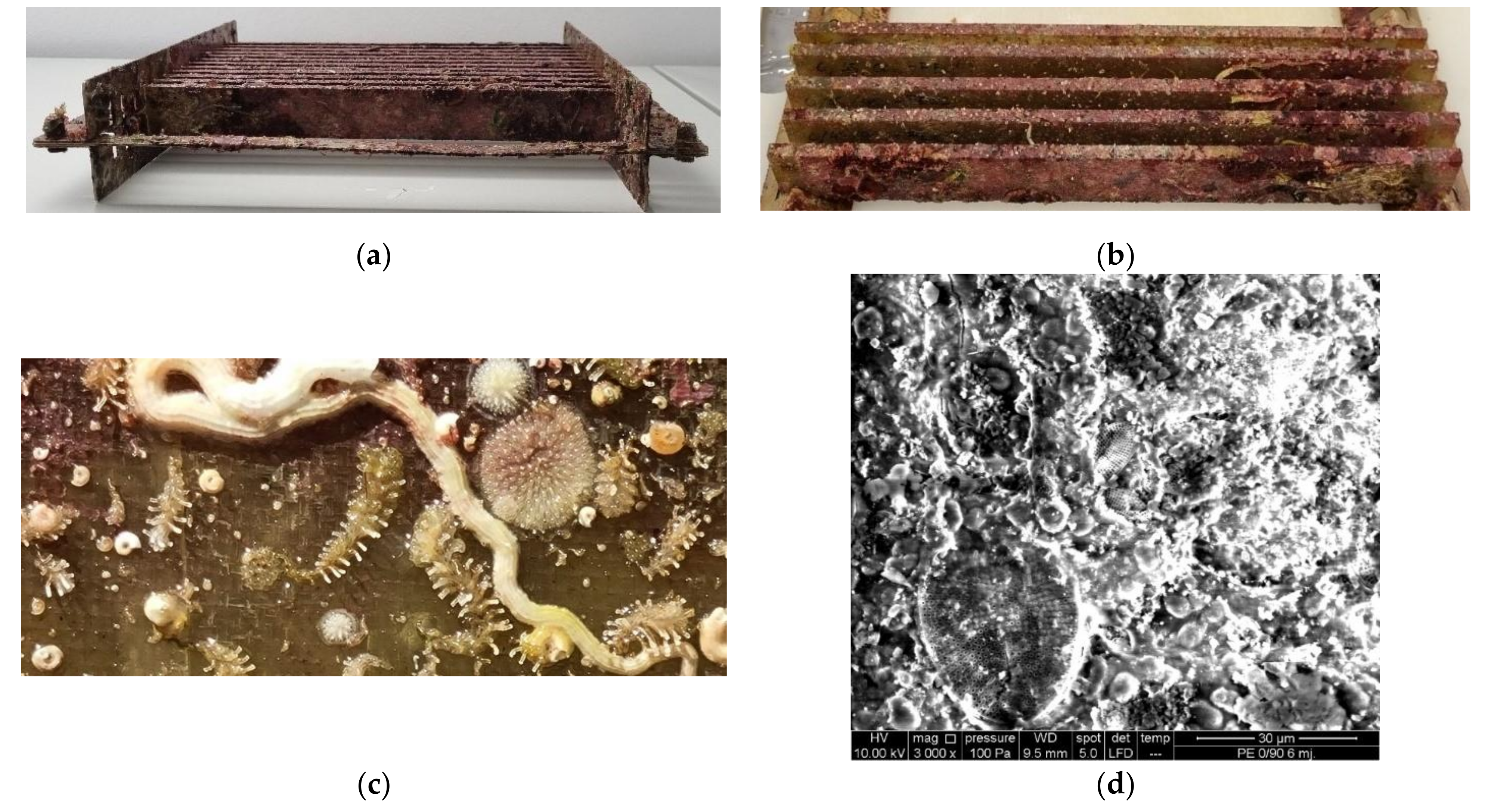

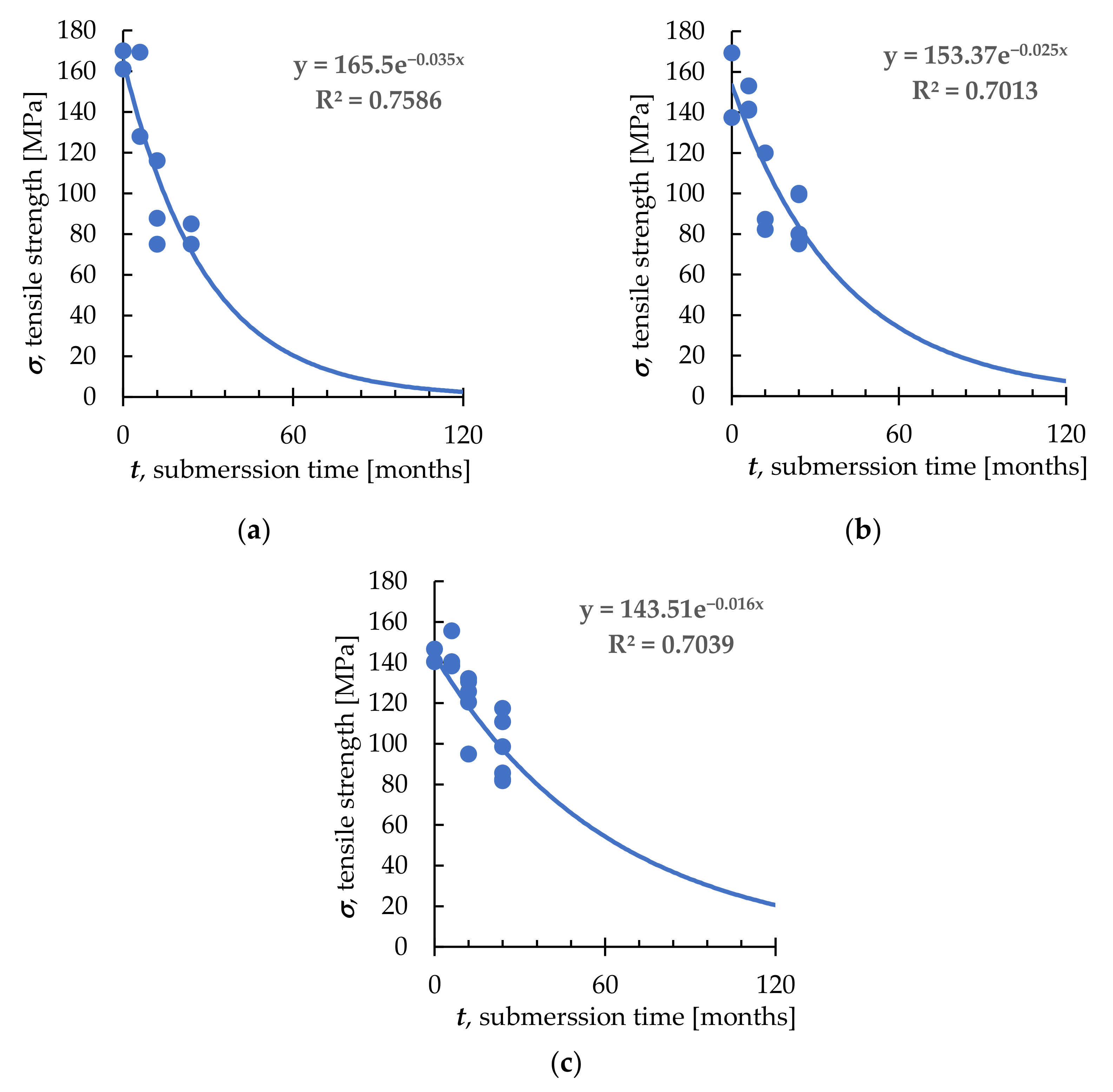
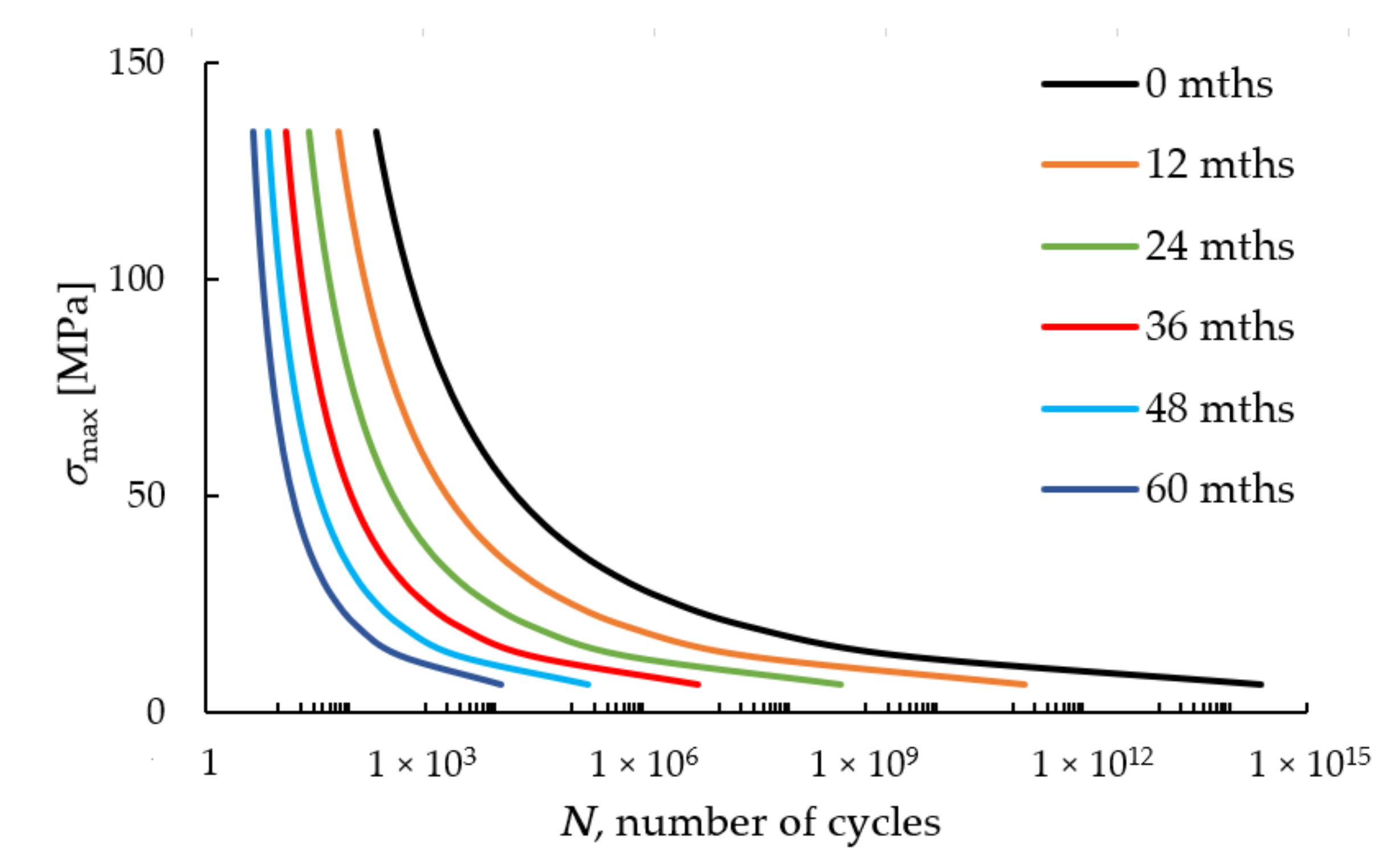
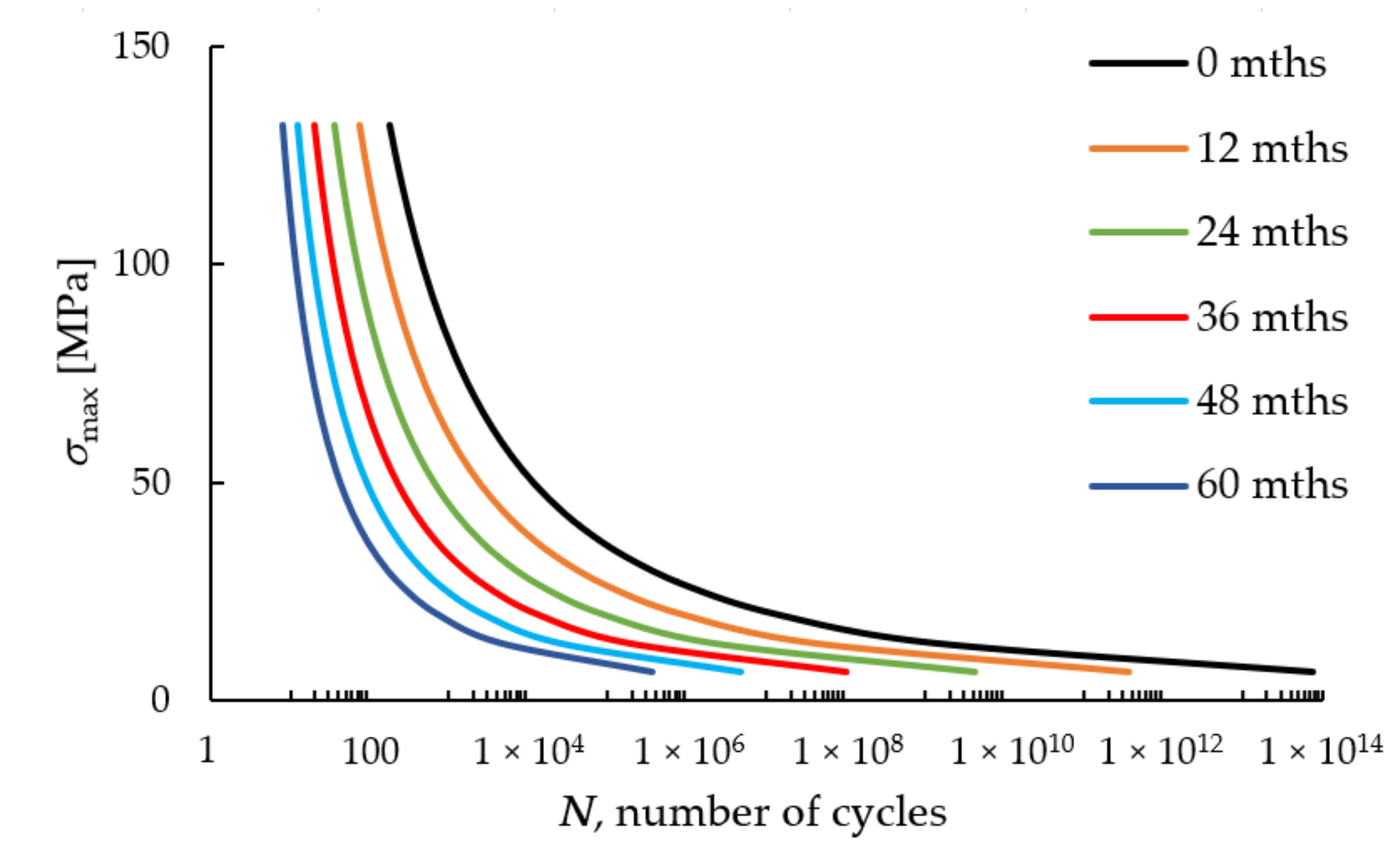
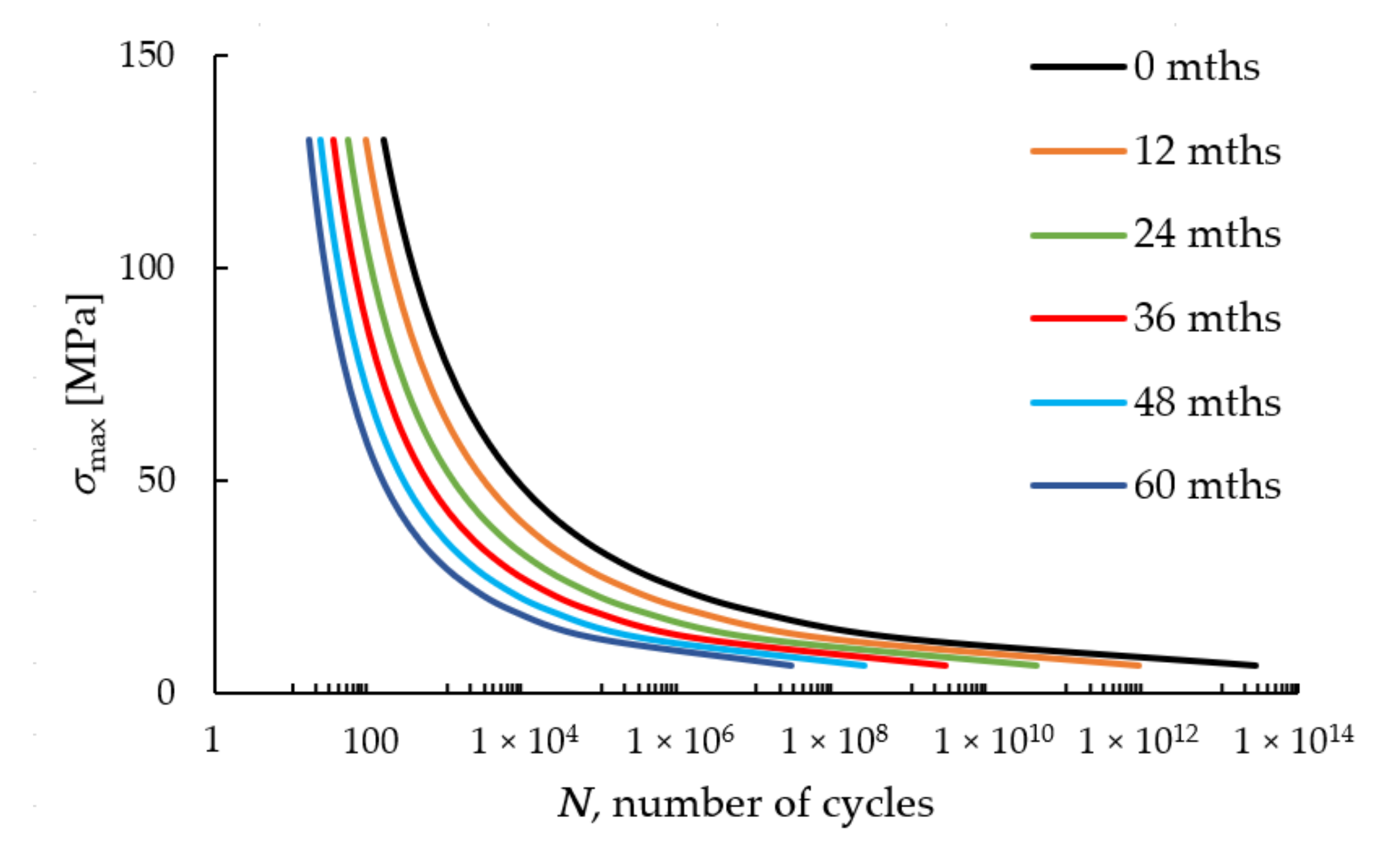
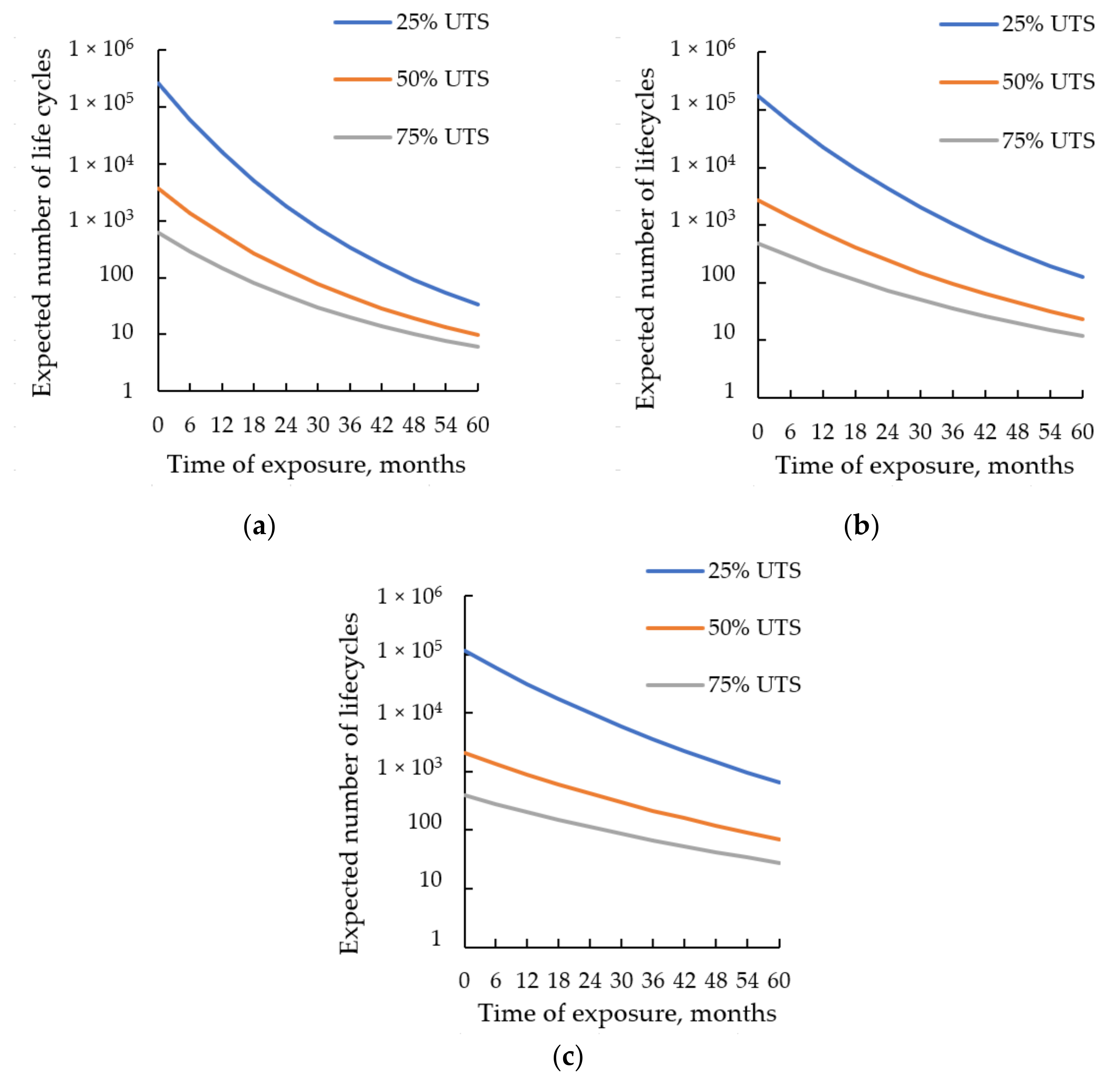
| Fiber Layout Configuration | Coefficient A | Coefficient B | R2 Value |
| UD0° | 165.50 | −0.0349 | 0.7079 |
| (0/90) s | 153.37 | −0.0252 | 0.6557 |
| (0/45/90) s | 143.51 | −0.0162 | 0.6540 |
Publisher’s Note: MDPI stays neutral with regard to jurisdictional claims in published maps and institutional affiliations. |
© 2022 by the authors. Licensee MDPI, Basel, Switzerland. This article is an open access article distributed under the terms and conditions of the Creative Commons Attribution (CC BY) license (https://creativecommons.org/licenses/by/4.0/).
Share and Cite
Vizentin, G.; Vukelic, G. Prediction of the Deterioration of FRP Composite Properties Induced by Marine Environments. J. Mar. Sci. Eng. 2022, 10, 510. https://doi.org/10.3390/jmse10040510
Vizentin G, Vukelic G. Prediction of the Deterioration of FRP Composite Properties Induced by Marine Environments. Journal of Marine Science and Engineering. 2022; 10(4):510. https://doi.org/10.3390/jmse10040510
Chicago/Turabian StyleVizentin, Goran, and Goran Vukelic. 2022. "Prediction of the Deterioration of FRP Composite Properties Induced by Marine Environments" Journal of Marine Science and Engineering 10, no. 4: 510. https://doi.org/10.3390/jmse10040510
APA StyleVizentin, G., & Vukelic, G. (2022). Prediction of the Deterioration of FRP Composite Properties Induced by Marine Environments. Journal of Marine Science and Engineering, 10(4), 510. https://doi.org/10.3390/jmse10040510







